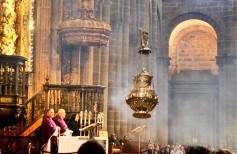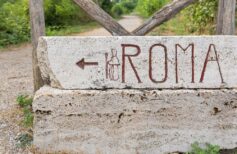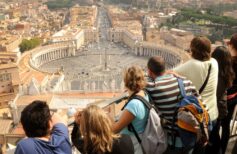For centuries, the Camino de Santiago has represented one of the most significant pilgrimages of faith that a person can undertake. Let’s see why embarking on it today is still meaningful.
Contents [hide]
Since the year 825 when Alfonso the Chaste, King of Asturias, made a pilgrimage with his court to the presumed tomb of the Apostle Saint James the Greater, discovered by a hermit named Pelagius on Mount Liberon, where lights resembling stars throbbed, countless footsteps have trodden the dust of the roads of the Camino de Santiago de Compostela. In fact, the eponymous town, capital of the autonomous community of Galicia in Spain, is to this day one of the most famous and visited pilgrimage sites in the world. The place where Pelagius found the necropolis containing, among others, the decapitated body of Saint James, was immediately named Campus Stellae, “field of the star,” hence Compostela. But the name could also simply derive from Campos Tellum, “ground of burial.”

5 places of pilgrimage to go to at least once in a lifetime
God’s action on this Earth leaves a strong mark that attracts us: here are five pilgrimages of faith to be made at least once in a lifetime…
The Camino de Santiago de Compostela thus originated, in the place where, according to the Golden Legend, the disciples of Saint James would have brought the decapitated body of the Apostle, executed in Palestine in the year 44 AD by order of Herod Agrippa I, on a boat guided by an angel. The visit of Alfonso the Chaste marked the beginning of pilgrimages. It was the same sovereign who ordered the construction of the first church, and as devotion to the Saint spread and pilgrims became increasingly numerous (Peregrinatio ad limina Sancti Jacobi), a first community of Benedictine monks settled in the Locus Sancti Iacobi. Soon the cult of Saint James spread beyond the Iberian Peninsula, and pilgrims began to increase, also thanks to the intervention of the King who took care to make the roads safer from Vikings and raiders and had the church expanded repeatedly. Even great personalities of secular power and the church began to go to Santiago de Compostela.
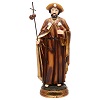
Today, the roads that make up the pilgrimage to Santiago de Compostela cross Spain and France, with different itineraries in terms of length and difficulty, but all declared UNESCO World Heritage Sites. The most used is the Camino Francés, which starts from Saint-Jean-Pied-de-Port, in the French Pyrenees, and crosses Navarre, La Rioja, Castile and León, and Galicia. On the French side, the stages of the Camino de Santiago are indicated by white-red signs, on the Spanish side by yellow arrows and by ceramic tiles depicting a yellow scallop shell on a blue background, linked to the legend about the discovery of the remains of Saint James the Apostle shipwrecked on the Spanish coasts while being brought to safety from Palestine. Some walk it, others ride a bike or a horse, and it takes about a month to reach Santiago de Compostela. After ups and downs that characterized a greater or lesser influx of pilgrims over the centuries, amid wars, periods of profound crisis and civil and religious insecurity, since the 1990s, the Camino de Santiago has confirmed itself as a pilgrimage route not only religious but also a symbol of integration among peoples, and many European and non-European associations have arisen to protect pilgrims and encourage their journey. Since October 1987, the Camino de Santiago has been declared a European Cultural Itinerary by the Council of Europe.

Saintly Pilgrims: 8 Patron Saints of Pilgrims and Travelers
Saintly pilgrims are saints for whom the experience of pilgrimage has been so significant that it became the very reason for their sanctity…
But what does it mean to undertake the Camino de Santiago today?
Why walk the Camino de Santiago
Once upon a time, those who embarked on a pilgrimage of faith did so driven by the desire to atone for an unforgivable sin or to make amends for a mortal sin. Pilgrims were easily recognizable because they carried signs, the distinctive signs of their state and their guilt, such as the staff, the typical curved handle stick, and the pouch, a small leather bag containing the little they could carry with them. Later, the devotional dimension of pilgrimages grew, undertaken not only by sinners but by those who wished to manifest their faith tangibly and with a profound experience. Over time, the pilgrimage has transformed into an experience of growth and inner enrichment, not only for Catholics wishing to confirm their faith but also as a spiritual strengthening experience for anyone willing to take a risk, perhaps facing a period of profound change decisively. Many are the pilgrimage sites that for centuries have attracted thousands of pilgrims every year. The Camino de Santiago is not only one of the religious itineraries that a Catholic Christian undertakes to manifest their devotion, but today it has become an inner challenge involving thousands of men and women eager to increase their spirituality, to rediscover a deeper connection with the world around them, with themselves, and inevitably, with their spirit.

Holy sinners: here are the most famous conversions
Holy sinners. A contradiction in terms? Not always. Here are the saints who converted after a life of sin…
The Cathedral of Santiago de Compostela
Today, the Cathedral of Santiago de Compostela is one of the largest and most famous Catholic shrines in the world. The destination of the Camino de Santiago, it bears the signs of the numerous expansion and restoration interventions it has undergone over the centuries. In its facades and inside, Romanesque blends with the Compostelan Baroque and Renaissance styles, with an artistic breath that recalls the infinite comings and goings of men and women of every nationality and social background who have succeeded here over time. We’ve dedicated an article to the Botafumeiro, one of the most famous and important symbols of the Cathedral, the immense censer used during solemn masses and special celebrations during the Holy Year.

The Botafumeiro, the largest thurible in the world
The Botafumeiro in the Santiago de Compostela Cathedral is the largest church thurible in the world, loved by all pilgrims that undertake…
The pilgrim’s compostela
Those who complete the Camino de Santiago de Compostela are entitled to obtain the Compostela, a religious document in Latin that the ecclesiastical authority of Santiago issues to those who demonstrate having completed the pilgrimage to the tomb of Saint James for religious reasons. It is a legacy of the medieval era when, to prove that the pilgrimage had been completed, and thus to deserve the expiation of the sins that had led to it, an official document was needed, allowing the pilgrim to be reintegrated into the civil and religious community. Just as pilgrims were equipped with passes in the past, today those who undertake the Camino carry a Credential, the pilgrim’s passport, which is stamped at each stage and which at the end of the journey entitles them to the Compostela.
For credentials for the Camino de Santiago to be valid, they must be issued by the Pilgrim’s Office and demonstrate that the pilgrim has traveled at least 100 km. The Compostela is issued only to those who undertake the Camino for religious reasons, not for tourism or sports.
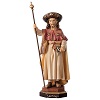
The shell of Santiago
One of the quintessential symbols of the Camino de Santiago is the scallop shell, or concha, which identifies the Camino throughout the world. Also known as St. James’s comb, it is a valve of a scallop. This is because in medieval times, pilgrims who had completed the Camino had to attest to its completion by going to collect a shell on the beaches of Finisterre, what the ancient Romans considered the westernmost point of the earth, the end of the world, finis terrae, precisely. According to legend, the disciples of Saint James, after losing the remains of the master in a shipwreck, found them on a beach covered with shells.

Today, the scallop shell of Saint James is used for decorative purposes, worn as a pendant or hung on the backpack during the Camino. On the Spanish side, in particular, it is visible affixed to walls and signs, embedded in sidewalks, and used as a decorative element everywhere. Once it also had a series of practical uses, akin to the staff and the pouch: it was used as a drinking vessel, for example.



